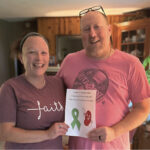
Keith McLaughlin has had a rough few years.
First he had progressive, degenerative diabetes. Then he was experiencing a rather embarrassing genital discharge. He also was a victim of an explosion, and he was in a bus accident. Then a few months ago, he was diagnosed with lung cancer.
He’s spent a lot of time at Penn State Health Milton S. Hershey Medical Center. But, in the end, he got a clean bill of health and even got paid for the time he spent at the hospital.
In reality, McLaughlin isn’t a patient but a performer. He is part of the Standardized Patient (SP) program at the medical center’s Clinical Simulation Center. Several times a year, he gets a script to follow, and he portrays a patient with a particular condition or problem. The SP program is one of several initiatives at the simulation center aimed at improving patient outcomes by promoting and enhancing practitioner skills, clinical competence, teamwork and interdisciplinary collaboration.
Like most of the 100 or so people who portray patients in the program, McLaughlin isn’t a professional actor. He actually is a retired accountant.
“This doesn’t come naturally to me,” he said. “It takes a lot of time and preparation.”
He reads through the scripts he is given and makes notes of key points to remember. SP participants also often must prepare to portray various emotions associated with the situation—such as anger, frustration or fear. Sometimes, the script calls for them to confess an embarrassing secret or to try to convince the doctor or nurse not to share bad news with a spouse. While they aren’t expected to give award-winning performances, they have to be convincing in these roles.
Participants often present the same case several times a day with different groups of students, which leads to more complications.
“After a while, it can be challenging to remember what you’ve said and to who,” said McLaughlin.
Nonetheless, it’s worth the time and energy.
“I want to help patients get the best possible care, and I want to help practitioners to feel more comfortable and confident interacting with patients,” he said.
It’s clear that he’s good at his job. After a multi-session program where he portrayed a patient with diabetes, he received a thank-you card signed by several of students who participated.
“Thank you for taking the time to teach us more about communication,” wrote one student. Another remarked, “It was clear that you really wanted to help us improve,” and another wrote, “I’ll always remember what you reminded all of us—that ‘before a patient is a patient, a patient is a person first.’”
While McLaughlin gets paid for his work in the SP program, helping medical practitioners get better at their jobs is a personal mission.
“My wife had breast cancer,” he said. “She was fortunate to have great doctors and nurses. I want to give back a bit for that. It makes me feel good. I want to do everything I can to make these simulations real for them.”
In Awe
Nursing student Caroline Farrell said that the SP program will help make her a stronger, more confident practitioner.
“It is useful to have the opportunity to mimic as closely as we can what we will see in the real world,” she said. “We’ll be able to pull from these experiences and apply them in our work.”
The program also helps to quell anxieties, said nursing student Natalie Sullivan.
“To be able to try things in a safe environment is tremendously helpful,” she said.
Not only are the simulations themselves useful, but, afterwards, the students get written feedback on their interactions. For this, they can learn first-hand from the “patient” what they did well, what information they missed, and what areas they might focus on for improvement.
Stacey Carmo, SP Program manager, said that she is constantly in awe of the quality of the simulations.
“It’s jaw-dropping how real some of them are,” she said. “We are fortunate to have great people involved in this program. Some of them have been doing it for as long as 15 years.”
The people, plus the mission of transforming students into excellent practitioners, help to make Carmo’s job a joy.
“Coming to work, I get excited every day,” she said.





